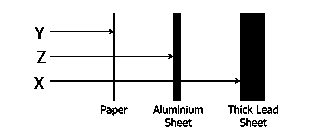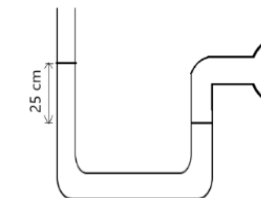0.94s
0.96s
0.93s
0.95s
Correct answer is B
d=312m.,T =263-10^°c = -10+273K = 263K, t=?
v= 331√ \frac{T}{273}
⇒ v = 331×√ \frac{263}{273}
⇒ v = 324.88 ms^-1
⇒ v = \frac{d}{t}
t = \frac{d}{t} = \frac {312}{324.88}
t = 0.96s

X = α-particle; Y = γ-ray; Z = β-particle
X = α-particle; Y = β-particle; Z = γ-ray
X = γ-ray; Y = α-particle; Z = β-particle
X = β-particle; Y = γ-ray; Z = α-particle
Correct answer is C
The penetrating power of alpha rays, beta rays, and gamma rays varies greatly. Alpha particles can be blocked by a few pieces of paper. Beta particles pass through paper but are stopped by aluminum foil. Gamma rays are the most difficult to stop and require concrete, lead, or other heavy shielding to block them.
Therefore, X = γ-ray; Y = α-particle; Z = β-particle
The sensitivity of a thermometer is
All of the above
how quickly a temperature change can be detected
the difference between the maximum and the minimum temperature
the smallest temperature change that can be detected or measured
Correct answer is D
The sensitivity of a thermometer is defined as the smallest temperature change that can be detected or measured, NOT how quickly that temperature change can be detected.
In contrast, the difference between the maximum and the minimum temperature is the range of a thermometer
108,986 Pa
165,238 Pa
122,364 Pa
134,645 Pa
Correct answer is D

density (ρ) = 13600 kgm^{-3}; g =9.8 ms^{-2}
P_{atm} =101,325 Pa; ρ=13600 kgm^{-3}
Pabs=P_{atm}+ρgh
⇒Pabs=101,325+13600 x 9.8 x 0.25
⇒Pabs=101,325+33320
⇒ Pabs=134,645Pa
29.36^o
25.37^o
37.21^o
34.75^o
Correct answer is D
n_1=1.33; n_2=1.5; i=40°; r= ?
from snell's law:
n_1 x sin i=n_2x sin r
⇒1.33 x sin 40°=1.5 x sin r
⇒sin r = 0.5700
⇒r = sin^{-1} (0.5700)
⇒ r = 34.75
JAMB Subjects
Aptitude Tests